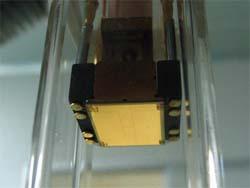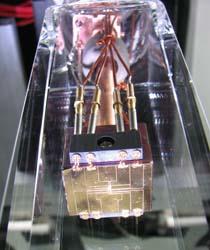

Scientists with the CAS Shanghai Institute of Optics and Fine Mechanics (SIOM) announced on Nov. 26 the successful development of China's first atom-chip system for achieving Bose-Einstein condensation (BEC), a milestone progress in ultracold atom research and quantum information storage technologies.
Although scientists from countries like the United States, France and Germany have already realized atom-chip BEC, Chinese researchers are second to achieve the feat in Asia , only after Japan.
With support from the National Basic Research Program, the work was chaired by Prof. WANG Yuzhu, a CAS Member, and carried out by the atom-chip group under the Laboratory for Quantum Optics, SIOM.
According to Prof. Wang, a BEC is a state of matter in which atoms are cooled to temperatures very near to absolute zero (0 K, about -273 C or -459 F). Under such conditions, a large fraction of the atoms will collapse into their lowest quantum state, and quantum effects become apparent on a macroscopic scale. Predicted in the 1920s by Indian physicist S. Bose and Albert Einstein, this exotic phenomenon was not observed until 1995 in dilute atomic gases for the first time. Now, BEC is a subject of intense theoretical and experimental studies with wide application in atom frequency standards, atom interferometer as well as the storage and process of quantum information.
As traditional apparatuses for the preparation of BEC are often expensive and huge in size, world scientists turn to cheaper and smaller experimental instruments. With the help of modern technologies of semiconductor manufacturing and micro-electro-mechanical system, some of them are now able to integrate the magnetic and optical systems into a silicon-based chip. When a surface electric current induces gradient magnetic fields on the chip, the atoms will be trapped and gradually frozen to extremely low temperatures. The BEC-on-a-chip not only is more stable and easier to carry, but can perform functions that traditional equipment could not.
Since it was established in the year 2003, the CAS group has installed China's first atom-chip optical electro-mechanical experimental setup including a ultrahigh vacuum system, an optical system, a frequency-stabilized laser device, an external magnetic field, along with high-resolution imaging and computer control systems for ultracold atom research. Their original design also involved an atom-chip capable of combining a magnetostatic trap with a high-frequency one.
Later they joined efforts with scientists from Zhejiang University to successfully prepare first such atom-chip in China. With these chips researchers were able to carry out a series of cutting-edge experiments, such as laser cooling and chip-surface evaporative cooling of atomic gases, magneto-optical trapping, atomic waveguides, and the splitting of ultracold atom clouds. They finally managed to cool down the atoms -- 3,000 of them in all -- to some 300 nK (nano Kelvin), at which point the phase transition of BEC was obtained.





